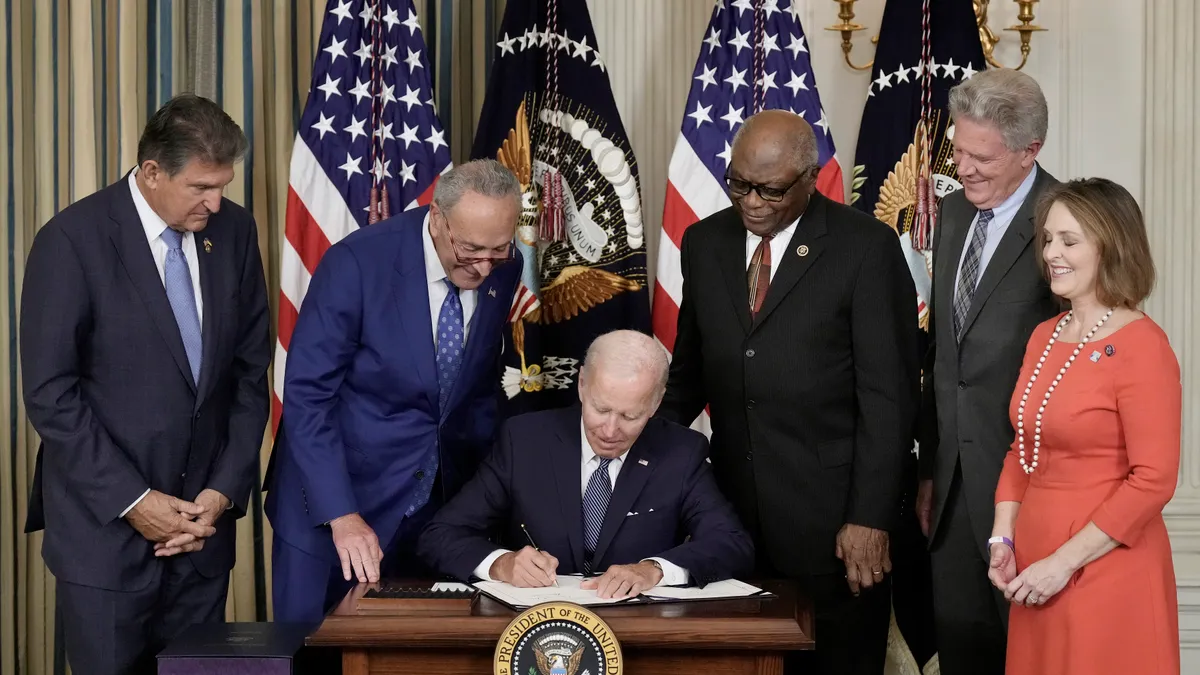With a stroke of his pen, President Biden on Tuesday signed into law a massive domestic policy package with drug pricing reforms all but certain to usher in sweeping changes to the way pharma companies do business.
The Inflation Reduction Act (IRA) — passed by the House on a 220-207 party-line vote last week and signed by President Biden Tuesday — is set to limit drug companies’ pricing power by allowing the HHS to negotiate what Medicare pays for medications, starting with 10 brands in 2026 and as many as 60 drugs by 2029. Furthermore, insulin prices for Medicare beneficiaries will be capped at $35 and out-of-pocket costs at $2,000, while pharma companies will pay rebates to Medicare beneficiaries if their prices rise faster than the rate of inflation.
“It is a change to a big book of business, which is the Medicare patient population,” Muna Tuna, U.S. market access, pricing and reimbursement leader at consulting firm EY, tells PharmaVoice. “The net impact of these pieces is going to be very individual based on the company's portfolio, pipeline, investments … every company needs to evaluate those three components from the perspective of commercialization as well as a development plan perspective.”
While it remains unclear which 10 drugs the HHS will target first for negotiation, the agency has said that it will choose from the 50 drugs that Medicare spends the most on, narrowing it down further to small molecule drugs that have been on the market for at least nine years and biologics that do not have any generic or biosimilar equivalent and have been available for at least 13 years. AARP suggests that some of these medications may include Bristol-Myers Squibb’s blood thinner Eliquis, Merck and Co.’s diabetes drug Januvia and Pfizer’s prostate cancer treatment Xtandi, among others. The HHS is expected to release its initial 10-drug list as early as Sept. 2023.

As drugmakers adapt to these policy changes and seek to mitigate their impacts, Tuna recommends three major business areas every company should reevaluate — pricing, R&D and commercial outreach.
1. The price is right
Setting the right price for a drug is key, and the IRA has made it even more important to find the sweet spot. With the new Medicare inflationary rebate policy in particular, companies must consider short- and long-term impacts as well as their brand’s future — including new indications down the road — when deciding on a launch price, Tuna says.
It’s especially important to consider pricing for drugs that address the 65-years-and-older Medicare population.
“While Medicare price negotiation will impact only a select number of drugs, we do expect there will be some impact to other products that compete in those therapeutic categories from a pricing perspective,” Tuna says.
To remain competitive with price-negotiated medications in the Medicare market, she suggests that companies with drugs in a similar indication area will also need to reassess the prices of their medication.
And although “there could be some secondary implications” on the commercial insurance side in the future, Tuna suggests those impacts are yet to be seen.
2. Prepping the pipeline
Considering the IRA’s deadlines for when small molecule drugs and biologics may be subject to Medicare price negotiation, Tuna says pharma companies should recalibrate the cost and benefit of drugs in their pipeline.
“There are choices around which assets to study … and in which indications, and the time to market,” Tuna says. “All three of those elements now are super important in the context of this bill because there is a limited amount of time once the product reaches the market.”
“While Medicare price negotiation will impact only a select number of drugs, we do expect there will be some impact to other products that compete in those therapeutic categories from a pricing perspective,"

Muna Tuna
Partner at EY
To make the most of their investments, drugmakers should closely examine whether drug development timelines can be accelerated, or whether trial strategies may be adjusted, Tuna recommends.
She also notes that the inflationary rebate measure may impact companies “looking to develop the same asset or drug in multiple indications over time.” With the new policy, companies will have less control in adjusting the prices of medications when they are approved for new indications.
Therefore, Tuna says it’s important for companies to carefully strategize a drug’s development, consider the sequence of indications and “factor the development potential and uncertainties across the life cycle into the launch price.”
3. Going commercial
With significant changes to pharma’s cost-setting and revenue-raising capabilities, Tuna also recommends companies lean into and optimize their commercial and marketing models. Earlier collaboration between R&D and market access teams will be crucial, she suggests.
Companies need to consider what resources to deploy to engage patients and doctors across the board, Tuna says, suggesting they think about doubling down on digital strategies, patient solutions and the way technology can help improve access to their products.
Companies may also look to drive additional revenue from products already on the market. One silver lining of the new policies for drug companies and patients, she says, is the potential that fewer Medicare patients may discontinue therapies due to cost. In a report published earlier this year, the HHS Office of Health Policy estimated that in 2019 over 5 million Medicare patients struggled to afford their medications, with Black and Latino adults disproportionately impacted.
“With the cap of $2,000 on out-of-pocket spend, hopefully there'll be more patients who can afford drugs and can afford to stay on therapy longer than they do today,” Tuna suggests. The additional revenue gained from potential prolonged use of medications by patients likely won’t create a net offset of the other provisions, Tuna says, but it does create a possibility for increased drug sale volume.


















